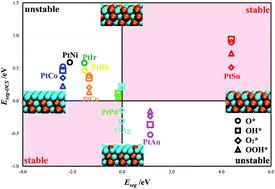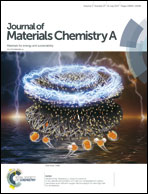The enhanced oxygen reduction reaction performance on PtSn nanowires: the importance of segregation energy and morphological effects†
Abstract
In this study, the reaction mechanism and electrochemical properties of carbon-supported PtSn nanomaterials including nanoparticles and nanowires (NWs) toward the oxygen reduction reaction (ORR) have been investigated computationally and experimentally. Segregation energy calculations were applied to screen the unique thermodynamic stability of PtSn under ORR operation. Materials chemistry processing was further utilized to tailor the morphologies of PtSn NWs that have shown promoted ORR stability when compared to Pt NWs (24 vs. 83% decay during durability tests of 10 000 cycles). Additionally, these PtSn NWs with a Pt rich inner core and an Sn rich outer shell structure also showed an enhancement in ORR activity from electrochemical tests. The enhanced performance, which has been rationalized by computation and various experimental techniques of high resolution transmission electron microscopy, X-ray diffraction, X-ray photoelectron spectroscopy and X-ray absorption spectroscopy, can be attributed to Sn and its oxides inducing change of electronic structures and the morphological effects, which not only reduce oxophilicity and the d-band center of surface Pt but also stabilize the structure during the durability test.


 Please wait while we load your content...
Please wait while we load your content...